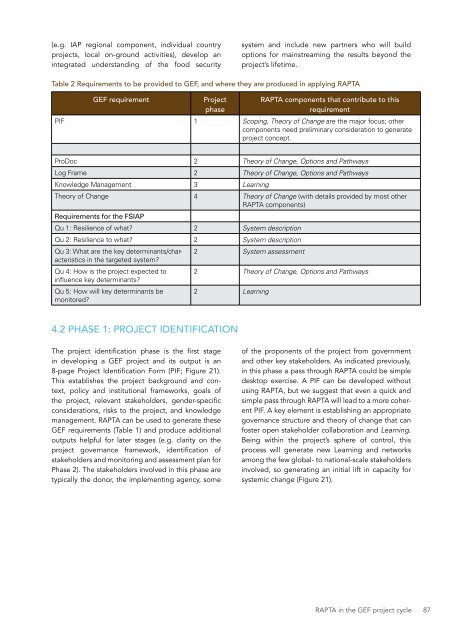DESIGNING PROJECTS IN A RAPIDLY CHANGING WORLD
srun3013fp1
srun3013fp1
You also want an ePaper? Increase the reach of your titles
YUMPU automatically turns print PDFs into web optimized ePapers that Google loves.
(e.g. IAP regional component, individual country<br />
projects, local on-ground activities), develop an<br />
integrated understanding of the food security<br />
system and include new partners who will build<br />
options for mainstreaming the results beyond the<br />
project’s lifetime.<br />
Table 2 Requirements to be provided to GEF, and where they are produced in applying RAPTA<br />
GEF requirement<br />
Project<br />
phase<br />
RAPTA components that contribute to this<br />
requirement<br />
PIF 1 Scoping, Theory of Change are the major focus; other<br />
components need preliminary consideration to generate<br />
project concept.<br />
ProDoc 2 Theory of Change, Options and Pathways<br />
Log Frame 2 Theory of Change, Options and Pathways<br />
Knowledge Management 3 Learning<br />
Theory of Change 4 Theory of Change (with details provided by most other<br />
RAPTA components)<br />
Requirements for the FSIAP<br />
Qu 1: Resilience of what? 2 System description<br />
Qu 2: Resilience to what? 2 System description<br />
Qu 3: What are the key determinants/characteristics<br />
2 System assessment<br />
in the targeted system?<br />
Qu 4: How is the project expected to 2 Theory of Change, Options and Pathways<br />
influence key determinants?<br />
Qu 5: How will key determinants be<br />
monitored?<br />
2 Learning<br />
4.2 PHASE 1: PROJECT IDENTIFICATION<br />
The project identification phase is the first stage<br />
in developing a GEF project and its output is an<br />
8-page Project Identification Form (PIF; Figure 21).<br />
This establishes the project background and context,<br />
policy and institutional frameworks, goals of<br />
the project, relevant stakeholders, gender-specific<br />
considerations, risks to the project, and knowledge<br />
management. RAPTA can be used to generate these<br />
GEF requirements (Table 1) and produce additional<br />
outputs helpful for later stages (e.g. clarity on the<br />
project governance framework, identification of<br />
stakeholders and monitoring and assessment plan for<br />
Phase 2). The stakeholders involved in this phase are<br />
typically the donor, the implementing agency, some<br />
of the proponents of the project from government<br />
and other key stakeholders. As indicated previously,<br />
in this phase a pass through RAPTA could be simple<br />
desktop exercise. A PIF can be developed without<br />
using RAPTA, but we suggest that even a quick and<br />
simple pass through RAPTA will lead to a more coherent<br />
PIF. A key element is establishing an appropriate<br />
governance structure and theory of change that can<br />
foster open stakeholder collaboration and Learning.<br />
Being within the project’s sphere of control, this<br />
process will generate new Learning and networks<br />
among the few global- to national-scale stakeholders<br />
involved, so generating an initial lift in capacity for<br />
systemic change (Figure 21).<br />
RAPTA in the GEF project cycle 87


